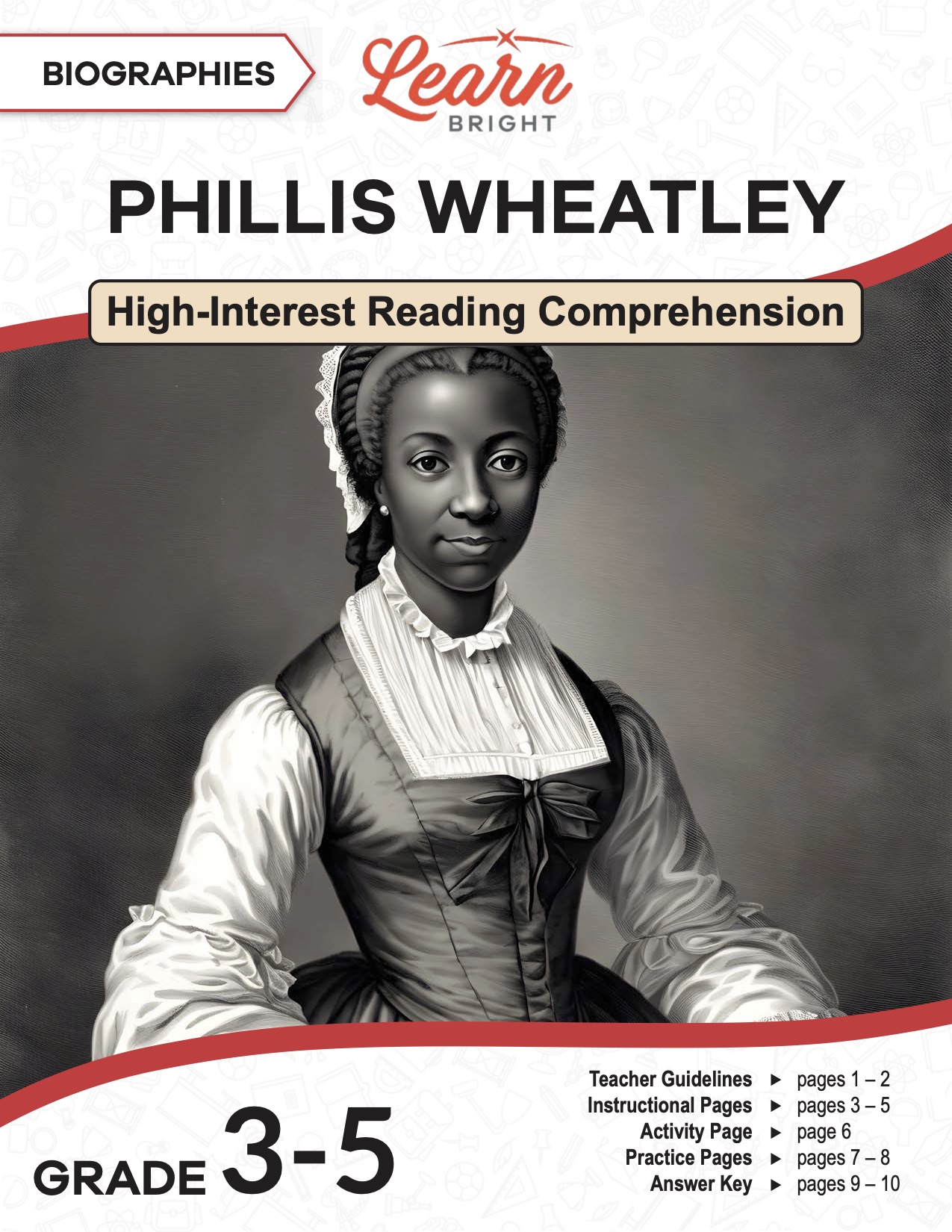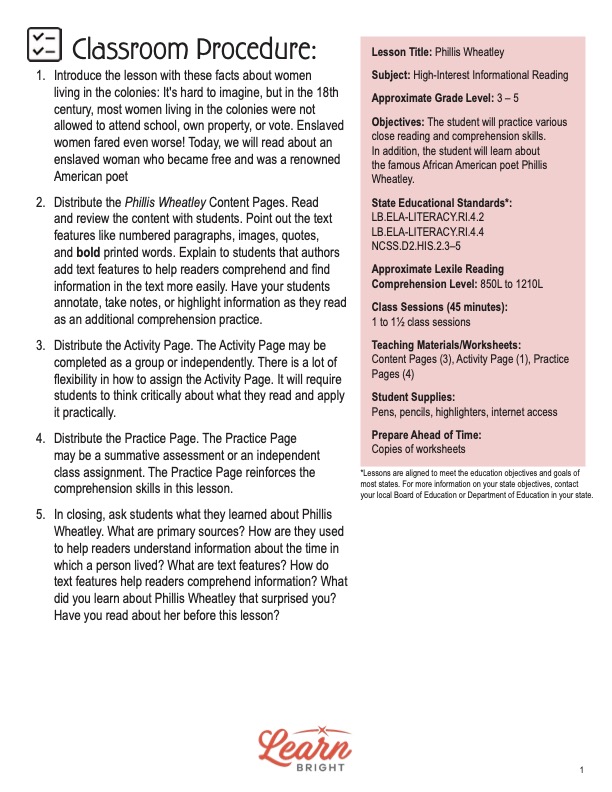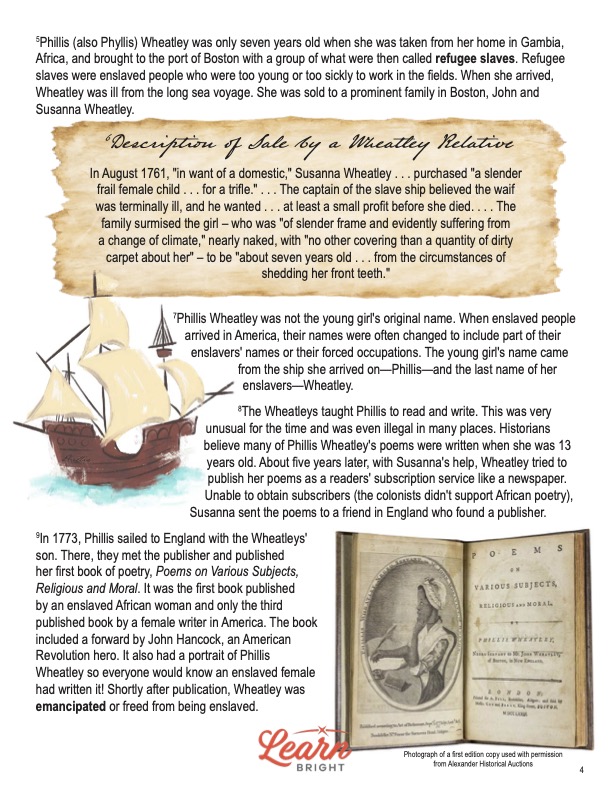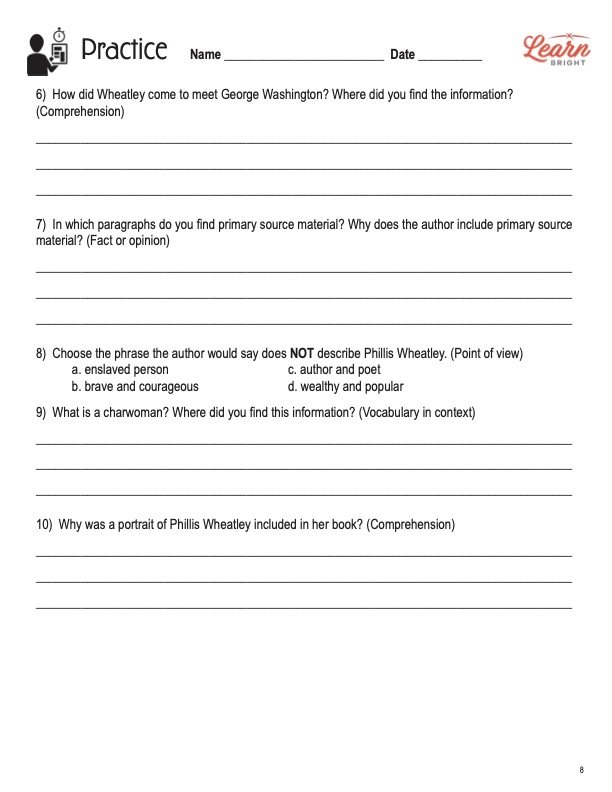Description
What our Phillis Wheatley lesson plan includes
Lesson Objectives and Overview: Phillis Wheatley is a high-interest reading comprehension lesson plan. As such, students will practice various close reading and comprehension skills. In addition, they will learn about the life and legacy of an amazing poet. This lesson is for students in 3rd grade, 4th grade, and 5th grade.
Classroom Procedure
Every lesson plan provides you with a classroom procedure page that outlines a step-by-step guide to follow. You do not have to follow the guide exactly. The guide helps you organize the lesson and details when to hand out worksheets. It also lists information in the yellow box that you might find useful. You will find the lesson objectives, state standards, and number of class sessions the lesson should take to complete in this area. In addition, it describes the supplies you will need as well as what and how you need to prepare beforehand. Your students may need access to the internet for this lesson.
Teacher Notes
The paragraph on this page provides a little more information or guidance on what to expect from the lesson. It explains that you can teach this lesson in a whole-class setting or as an independent, small-group activity. You can use the blank lines to record any thoughts or ideas you have as you prepare.
PHILLIS WHEATLEY LESSON PLAN CONTENT PAGES
Colonial America
The Phillis Wheatley lesson plan contains three content pages. It begins by providing background information on what life was like in colonial America before the Revolutionary War. Colonists had not yet explored the American continent beyond the Ohio River. They settled into 13 colonies along the east coast. Great Britain ruled these colonies. American independence from Great Britain would not happen until 1776.
America was far different then. Most children did not attend school. Local ministers or teachers taught the ones who did. The roles of men and women were also very different. Men were the breadwinners, and women were responsible for the home. On farms, women were responsible for the children but also had to work with the men. From the time they could walk, children worked as well!
In colonial America, women could not own property or vote. Working outside of the home was frowned upon. Males from wealthy families were taught to read, write, and do math and learned about history. Wealthy females were also taught to read and learned the domestic arts. Domestic arts were the skills needed to maintain a “proper” household. Women were not taught subjects like math or history because they were not considered helpful to their societal role.
Nearly all the colonies relied on enslaved people to support their local economies. Many of the port cities in the north maintained slave auction houses. These were public squares where humans were sold to the highest bidder. This is where the story of Phillis Wheatley begins!
Phillis Wheatley
Phillis (also Phyllis) Wheatley was only seven years old when she was taken from her home in Gambia, Africa, and brought to the port of Boston with a group of what were then called refugee slaves. Refugee slaves were enslaved people who were too young or too sickly to work in the fields. When she arrived, Wheatley was ill from the long sea voyage. She was sold to a prominent family in Boston, John and Susanna Wheatley.
Phillis Wheatley was not the young girl’s original name. When enslaved people arrived in America, their names were often changed to include part of their enslavers’ names or their forced occupations. The young girl’s name came from the ship she arrived on—Phillis—and the last name of her enslavers—Wheatley.
The Wheatleys taught Phillis to read and write. This was very unusual for the time and was even illegal in many places. Historians believe Phillis Wheatley wrote many of her poems when she was just 13 years old. About five years later, with Susanna’s help, Wheatley tried to publish her poems as a readers’ subscription service like a newspaper. Unable to obtain subscribers (the colonists didn’t support African poetry), Susanna sent the poems to a friend in England who found a publisher.
Poetry
In 1773, Phillis sailed to England with the Wheatleys’ son. There, they met the publisher and published her first book of poetry, Poems on Various Subjects, Religious and Moral. It was the first book published by an enslaved African woman and only the third published book by a female writer in America. The book included a forward by John Hancock, an American Revolution hero. It also had a portrait of Phillis Wheatley so everyone would know an enslaved female had written it! Shortly after publication, Wheatley was emancipated or freed from being enslaved.
Wheatley was a supporter of the Revolutionary War. Though she supported the war, she believed slavery would continue to be a moral stain on the cause for liberty. In 1776, George Washington invited her to meet him in Massachusetts. Wheatley had written a poem about him, and he was said to admire her work. While living in Boston, Wheatley met many of the heroes and leaders of the American Revolution.
Tragedy
In 1778, Wheatley married John Peters. Peters could not earn a living because of the harsh post-war economic conditions. To help support them, Wheatley worked as a charwoman, cleaning the houses of wealthy Bostonians. Peters eventually went to jail for not paying his debts. Wheatley found herself living in a run-down apartment in extreme poverty. She continued to write but could find no one to publish or support her work.
Sadly, years of illness and poverty took its toll on Wheatley. She died alone and uncared for at the age of 31. Her poetry continues to live on as some of the finest works in American history. Wheatley’s fearless and tireless efforts to end enslavement encouraged others to join the anti-slavery movement. Her incredible journey from the coast of Africa to enslavement in colonial America to her rise as one of the greatest authors in American history symbolizes the struggle for equality.
PHILLIS WHEATLEY LESSON PLAN WORKSHEETS
The Phillis Wheatley lesson plan includes two worksheets: an activity worksheet and a practice worksheet. Each one will help students solidify their grasp of the material they learned throughout the lesson. You can refer to the classroom procedure guidelines to know when to hand out each worksheet.
ON IMAGINATION ACTIVITY WORKSHEET
For this activity, students will practice their analyzing skills. They will first silently read through an excerpt from one of Phillis Wheatley’s poems. Then they will underline words they don’t understand and look them up to find their meaning. The worksheet provides a few lines for them to write down what they believe Phillis was saying in the poem. After reading the poem to someone else, they will rewrite it in their own words in the space provided.
PHILLIS WHEATLEY PRACTICE WORKSHEET
The practice worksheet requires students to answer a series of 10 questions. These questions all relate to the content pages, so students will need to refer to them often for the answers. In addition, each question provides which reading tool the question corresponds to, such as text feature, vocabulary, or comprehension.
Worksheet Answer Keys
At the end of the lesson plan document is an answer key for the practice worksheet. The correct answers are all in red to make it easier for you to compare them with students’ responses. If you choose to administer the lesson pages to your students via PDF, you will need to save a new file that omits these pages. Otherwise, you can simply print out the applicable pages and keep these as reference for yourself when grading assignments.









